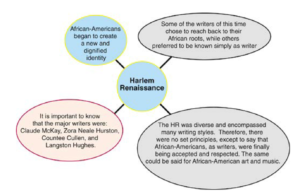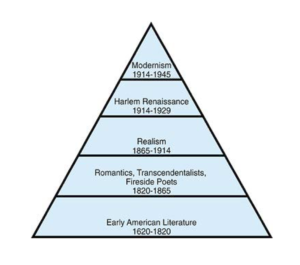 username@email.com
username@email.com
This lesson will examine major American literary movements, schools of thought, and the writers who influenced and shaped them.
Much of American literature parallels the nation’s historical events. In keeping with that fact, it makes sense that colonial literature was the first major literary period in America. The atmosphere of the time was serious and religious. Much of the writing reflects the trials and experiences of the settlers and what the founders encountered in the New World. Life was hard for them, and they often depended on their faith in God to pull them through. Due to religious persecution, the Puritans left England to settle in America. This accounts for the heavy Puritan influence that permeated much of colonial literature.
Here are some key principles of colonial literature for you to know.
Early American Literature:
The following are the major writers and their works you should know:
|
Major Colonial Writers
|
||
|
Writer |
Work |
Background |
| Jonathan Edwards | “Sinners in the Hands of an Angry God” | Edwards was a Puritan preacher. His writing reflects his fire and brimstone attitude. This sermon is typical of the Puritan outlook on life and faith. |
| Anne Bradstreet | “Here Follows Some Verses Upon the Burning of Our House” | Bradstreet took the burning of her house as a sign that she was too focused on material goods. |
| John Smith | “The General History of Virginia, New England, and the Summer Isles” | John Smith was an important literary figure because of his historical contribution. He was the first leader of Jamestown.
The book explains how difficult life was for the settlers and their descendants. |
The Romantic movement originated in continental Europe, spread to England, and finally landed in the United States. This period occurred during a time of great change in America. The country was looking inward and focusing on itself. This focus can be seen in the key principles of Romanticism:
Some of the key Romantic writers and their works include:
Some key notes on these major works:
|
Major Romantic Works to Know
|
|
|
Work |
Summary |
| “The Tell-Tale Heart” by Edgar Allan Poe | A psychological thriller in short story format, it tells the story of one man’s experience of plotting and killing another. |
| “Rip Van Winkle” by Washington Irving | This light-hearted short story explores how one man was removed from society for many years only to come back to a changed world a completely unchanged person. |
| The Scarlet Letter by Nathaniel Hawthorne | The main character is a woman who has been ostracized from her Puritan community for having an affair, and giving birth to a daughter while refusing to divulge the identity of the father, despite the fact that her husband had been missing for many years. |
| Moby Dick by Herman Melville | In this novel, a sea captain tells of his journey to capture Moby Dick, the elusive and legendary whale. |
The Romantic movement encouraged many writers to document their ideas using the medium of poetry. This group of poets was called the Fireside poets. They were household names, famous and widely read while they were alive. Here are a couple of key principles to know about them:
Aside from knowing about the Fireside poets, it is important to know some of their works:
William Cullen Bryant:
Oliver Wendell Holmes:
Henry Wadsworth Longfellow:
James Russell Lowell:
John Greenleaf Whittier:
In some ways the Romantics bred the Transcendentalists, as the two share similar themes in their work. The major difference is that the Transcendentalists focused more on nature and the individual’s relationship with it. A key term tied to this group is self-reliance. Self-reliance conveys the ideal of living without the niceties of society and materialism. Transcendentalists believed that an ideal spiritual state existed once one transcended the physical and empirical world. They celebrated the self and considered the individual an integral part of nature. Three major American writers came from this movement.

Let’s stop here for a moment and review. The next part of American literature indicates a great shift in thinking so this is a good place to break and look at what we have covered.

A student is interested in writing a report on what life would have been like for some of the first American Puritan settlers. Which of the following writers should the student look to?
After 1865 the United States experienced a significant amount of growth and expansion. Things were settling down after the Civil War, and the nation was advancing toward World War I. Writers and citizens began to lose their romantic notions and were moving toward a more realistic worldview. As a result, the next literary period to influence American writing was aptly dubbed Realism. As we progress through the lesson, keep in mind the fact that Realism was a reaction to Romanticism.
Key principles of Realism:
Major Realists include Samuel Clemens (Mark Twain), whose Adventures of Huckleberry Finn uses the vernacular to tell the tale of a boy born poor and unhappy. The book concerns itself with the important issues of the day: racism and slavery.
Another Realist to remember is Henry James. His Daisy Miller, in true Realist fashion, provides detailed and realistic character descriptions and presents characters that are lifelike.
William Dean Howells, Edith Wharton, and Sarah Orne Jewett are also notable major American writers of this period.
Starting in 1920, a truly unique outburst of creative works by African-Americans sprung forth in music and the literary and visual arts. This cultural movement was first known as “the New Negro Movement” which evolved into “The Harlem Renaissance.” This movement exalted the talents of African-Americans and served to redefine the culture’s mode of creative expression.
Spurred by the great African-American migration northward to cities such as Washington, D.C., Chicago, Greenwich Village and Harlem in Manhattan, between the years 1920 and 1940, this richly dynamic mix of radical black intellectuals, writers, painters, and gave birth to an unprecedented time of success for black artists of all kinds.

Important works of the time include:
|
Major Works of the Harlem Renaissance
|
||
|
Literary Work |
Author |
Brief Description |
|
Their Eyes Were Watching God |
Zore Neale Hurston | This novel depicts a woman’s return to the South and her attempt to define herself as a woman and an African-American. |
| “America” | Claude McKay | This poem describes the treatment of African-Americans and the prejudice they experienced. |
| “Theme for English B” and “Dream Deferred” | Langston Hughes | These two poems explore the idea of identity and what it’s like to be an African-American in a nation that discriminates against that particular identity. |
As the Harlem Renaissance was winding down, the Modernist movement was gathering momentum in the United States. Modernism in America took hold in the period between World War I and World War II (1917–1945). During this time, the United States was experiencing a great economic and artistic shift. The Great Depression was a huge influence as was the somber mood of war. Following are some key principles to remember about this brief but powerful time in literature:

Major Modernist prose writers include:
Major Modernist poets include:
Major Modern dramatist:
The following is a quick reference chart that illustrates the history of American literature:

If you were writing a lesson about the idea of self and its interaction with nature, which of the following texts would be most applicable?